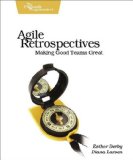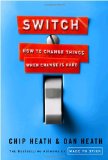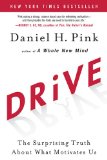
Image via Wikipedia
Whenever we talk at these Meetups about adopting agile practices, my first response is that it all begins from the retrospectives. If an organization can examine how they are doing and find ways to make steady improvements, then they can greatly change how they work in positive and highly productive ways. There are simple ways to kickstart this process and then adapt locally as things begin to click.
Our retrospectives generally follow the framework outlined in Esther Derby and Diana Larsen's Agile Retrospectives: Making Good Teams Great . This framework helps to keep the retrospective on track and flowing:
. This framework helps to keep the retrospective on track and flowing:
Set the Stage
Gather Data
Generate Insights
Decide What to Do
Close the Retrospective
There are dozens of excellent activities in the Agile Retrospectives book to help you get started or to inject new energy into your retrospectives. When you combine this information with the insights from Switch and Drive, you are well on your way to building a solid toolkit for affecting positive change in your day-to-day and long-term work environment.
- Set the Stage: getting the team ready to engage in the retrospective
- Gather Data: create a shared picture of what happened during the retrospective
- Generate Insights: interpret and analyze the data to figure out what happened
- Decide
What To Do: identify highest priority items to work on and put measurable goals on those items so they can be completed
- Close the Retrospective: reflect on the retrospective and how to improve it, and appreciate the accomplishments of the team and individual interactions
Set the Stage
- welcome everyone to the retrospective and express appreciation of the hard work leading up to the retrospective and their willingness to attend
- provide a short amount of time for everyone to speak so they will be more comfortable speaking later: introductions or a short answer to a question like "what are you looking for from this retrospective?"
- describe the agenda, working agreements and timeboxes for the phases to follow
Gather Data
- capture data about what happened during the period: events, metrics, stories, customer wins, feelings
- try to avoid analysis at this stage. you want to capture lots of unfiltered information
Generate Insights
- ask why things happened: conditions, interactions, patterns, breakdowns, bright spots, successes
- dig to get root causes; first impressions are often correct but do not always tell the whole story
Decide What to Do
- insights generate potential experiments and improvements - what are the highest priority? the biggest impact? the most likely to succeed?
- focus on a small number of items (maybe 1!) until you establish the pattern of success
- create paths that build on past successes and things you are already doing
- engage both the rational and emotional side of people to improve chances
Close the Retrospective
- ensure the team captures what happened during their retrospective and plan to follow up
- retrospect on the retrospective to make it even better next time
- take time for the team to appreciate their accomplishments and celebrate these
- appreciate the time and effort that people put into helping to improve their team
There are dozens of excellent activities in the Agile Retrospectives book to help you get started or to inject new energy into your retrospectives. When you combine this information with the insights from Switch and Drive, you are well on your way to building a solid toolkit for affecting positive change in your day-to-day and long-term work environment.
 |
 |
 |
| Agile Retrospectives: Making Good Teams Great Esther Derby, Diana Larsen |
Switch: How to Change Things When Change Is Hard Dan Heath, Chip Heath |
Drive Daniel Pink |

Leave a comment